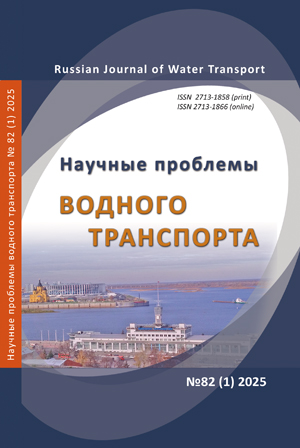Analysis of factors affecting the safety of navigation
Abstract
The article presents a study of the factors affecting the safety of navigation on sea and inland waterways. It is noted that the accident rate of ships in conditions of heavy traffic has increased rapidly and, often, human errors are the main cause of incidents. Based on the study of international and national regulatory documents, as well as scientific approaches of domestic and foreign scientists, the systematization of the main groups of factors has been carried out, divided into internal and external, which proves that it allows comprehensive consideration of issues of ensuring the safety of navigation. It is emphasized that the scientific literature considers a wide range of components that determine the reliable movement of ships, such as: natural and climatic conditions, environmental conditions, regulatory and legal regulation, technical condition of ships, operating conditions of ships and others. At the same time, most scientists single out the human factor as a key aspect ensuring the stability of the vessel's operation. Developing this approach, the article presents a detailed hierarchy of the influence of the human factor on the safety of navigation developed by the author, which highlights the components of direct and indirect impact, grouped by categories: professional and physical condition of ship crews, compliance with working conditions, nutrition and medical care, technical aspects, regulatory support: international and national documents, organizational provision, technical support, infrastructure support, information support and social and labor support. The results of the study demonstrate their importance and the need to integrate them into corporate management processes, which will allow a comprehensive approach to the development of measures to improve the safety of navigation and minimize risks.
References
Федеральная служба по надзору в сфере транспорта [Электронный ресурс]. – Режим доступа: https://rostransnadzor.gov.ru/ (дата обращения: 01.11.2024).
Развозов С.Ю. Безопасность судоходства / С.Ю. Развозов. – СПб.: ГУМРФ им. адм. С.О. Макарова, 2014. – 344 с.
Дмитриев В.И. Пути повышения безопасности судоходства / В.И. Дмитриев. – М.: Моркнига, 2015. – 223 с.
Дмитриев В.И. Обеспечение безопасности плавания судов / В.И. Дмитриев. – М.: Моркнига, 2018. – 349 с.
Каретников В.В. Исследование влияния усталости судоводителя на процесс обеспечения безопасности судоходства / В.В. Каретников, С.В. Козик, И.А. Соколова // Вестник Государственного университета морского и речного флота имени адмирала С.О. Макарова. – 2017. – Т. 9. - № 2. – С. 272-279.
Чернышев В.Ф. Человеческий фактор при авариях на судах. Материалы 4-ой НТК «Проблемы безопасности морского судоходства, технической и коммерческой эксплуатации морского транспорта». 2005. – С. 31-32.
Васильев С.А. Международно-правовые меры обеспечения безопасности судоходства. Московский журнал международного права. 2021;(1):81-88. https://doi.org/10.24833/0869-0049-2021-1-81-88
Григорьев Н. Н. Формы и эффективность международной морской организации при борьбе с усталостью моряков / Н.Н. Григорьев, Д.Б. Сигаев // Вестник Государственного университета морского и речного флота имени адмирала С. О. Макарова. - 2017. - №3(43).
Ермаков С. В. Превентивное регулирование человеческого фактора в морском судовождении С.В. Ермаков // Вестник Государственного университета морского и речного флота имени адмирала С. О. Макарова. - 2016. - №5(39). - C. 39-50.
Афонин А. Б. Комплексная оценка безопасности плавания в акватории северного морского пути / А.Б. Афонин // Вестник Государственного университета морского и речного флота имени адмирала С. О. Макарова. - 2018. - №6(52). - C. 1132-1142.
Масюк Н. Н., Блюдик А. Р. Современные тенденции цифровой трансформации в морской отрасли // ЕГИ. 2022. №6 (44). URL: https://cyberleninka.ru/article/n/sovremennye-tendentsii-tsifrovoy-transformatsii-v-morskoy-otrasli (дата обращения: 13.11.2024).
Chowdhury, M.N., Shafi, S., Arzaman, A.F.M., Teoh, B.A., Kadhim, K.A., Salamun, H., Kadir, F.K.A., Said, S., Kadir, K.A., Embong, A.M., Aziz, N.A.A., Jusoh, M.H., Pham, L.H.H.P., Xuan, A.N.S. (2024). Navigating human factors in maritime safety: A review of risks and improvements in engine rooms of ocean-going vessels. International Journal of Safety and Security Engineering, Vol. 14, No. 1, pp. 1-14. https://doi.org/10.18280/ijsse.140101
Galieriková, A., Dávid, A., Sosedová, J. Fatigue in maritime transport. Sci. J. Bielsko-Biala Sch. Financ. Law 2020, 24, 35–38.
Томилин А.Н. К вопросу об усталости персонала судов как одной из существенных причин аварий на транспортных судах / А. Н. Томилин, А. Л. Боран-Кешишьян, С. Н. Томилина, Д. О. Яворская // Эксплуатация морского транспорта. – 2020. – № 3(96). – С. 15-23. – DOI 10.34046/aumsuomt96/3. – EDN JIPVUF.
Скороходов Д. А., Маринов М. Л. Учет влияния профессионального поведения специалистов в системе безопасности водного траспорта // Пожарная безопасность: проблемы и перспективы. 2014. №1 (5). URL: https://cyberleninka.ru/article/n/uchet-vliyaniya-professionalnogo-povedeniya-spetsialistov-v-sisteme-bezopasnosti-vodnogo-trasporta (дата обращения: 03.12.2024).
Гладкова А. М., Марушевский М. В., Фаустова О. Г. Искусственный интеллект и автоматизация в навигации и судоходстве. снижение влияния человеческого фактора // Вестник молодежной науки. 2021. №5 (32). URL: https://cyberleninka.ru/article/n/iskusstvennyy-intellekt-i-avtomatizatsiya-v-navigatsii-i-sudohodstve-snizhenie-vliyaniya-chelovecheskogo-faktora (дата обращения: 08.11.2024).
Дмитриев В.И. Практика мореплавания. - СПб.: "Элмор", 2009. -231 с. EDN: OWVXQF.
Ma, Xiao Fei, Guo You Shi, and Zheng Jiang Liu. 2023. "Unraveling the Usage Characteristics of Human Element, Human Factor, and Human Error in Maritime Safety" Applied Sciences 13, no. 5: 2850. https://doi.org/10.3390/app13052850.
Chauvin C. Human Factors and Maritime Safety. Journal of Navigation. 2011;64(4):625-632. doi:10.1017/S0373463311000142.
Copyright (c) 2025 Russian Journal of Water Transport

This work is licensed under a Creative Commons Attribution 4.0 International License.













